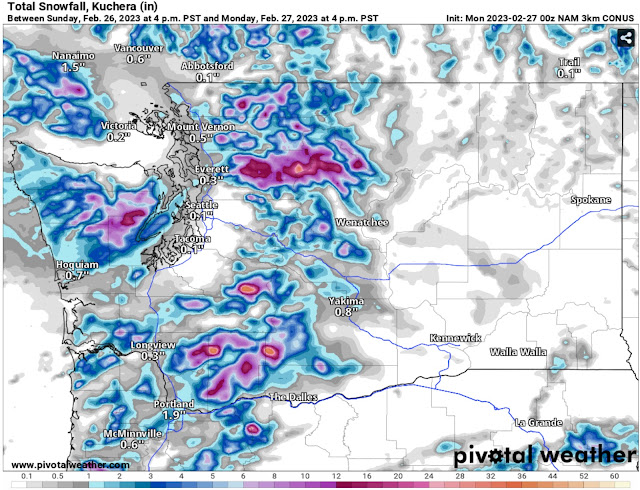500th Blog Post for The_Weatherman2
500 blog posts later, we still don't know where, when, or if it will snow in the lowlands! My first post on this blog, on January 16th, 2020, was about lowland snow. Tonight, we're again talking about snow, but also about the upcoming significant cold.
Let's start with the high-resolution snow forecasts. First is the NAM forecast through Wednesday night.
The NAM shows spotty areas of a trace to 1" of snow around the lowlands, with the highest amounts of 2-6" possible on the northern Olympic Peninsula, especially around Port Angeles and Sequim.Now for the HRRR forecast, also through Wednesday night.
The HRRR shows pockets of snow around the lowlands, mainly from Seattle north and on the Kitsap Peninsula. It agrees with the NAM in showing snow on the Olympic Peninsula, about 0.5-3" near the coast, and up to 2-6" along the Strait and in the mountains. The HRRR also shows snow from Olympia southward, with 1-3" possible in the Willamette Valley.Finally, the European model, historically the most accurate in snow situations around the Pacific Northwest.
The European model shows spotty pockets of a trace to 1" of snow around the lowlands, 1-3" for the Northern Olympic Peninsula, and 1-4" for most of Eastern Washington, except less around Yakima and the Tri-Cities.What about temperatures? Quite the chill is coming. Winds will accelerate out of the Fraser River Gap, gaps in the Cascades, and the Columbia River Gorge, as Arctic high pressure builds east of the mountains. With cold air in place, frigid wind chills and very cold mornings are expected.
Below is the European model forecast for Wednesday morning's lows.
Wednesday morning won't be too cold, with lows in the low to mid 30s for the lowlands, in the upper 20s for some outlying areas, and much colder, in the low teens to low 20s for Eastern Washington.However, brisk winds from the north will make it feel much colder across the state. Below is the European model forecast for wind chills at 7 AM Wednesday.
Brisk northerly winds will bring wind chills (feels-like temperatures) in the low to mid 20s for most of the lowlands, except in the upper teens for Whatcom, San Juan, and Clallam Counties, which are more exposed to the Fraser winds. Eastern Washington will have wind chills in the -5 to +15 degree range.Highs on Wednesday will reach the upper 30s to low 40s for the lowlands and mid 20s to low 30s for Eastern Washington. However, wind chills will keep feels like temperatures in the upper 20s to low 30s for Western Washington and low single digits to mid teens for Eastern Washington.
Temperatures get significantly colder overnight Wednesday into Thursday. Below is the European model forecast for lows on Thursday morning.
Expect Thursday morning's lows in the low to mid 20s for most of the lowlands, with outlying areas near the foothills dropping into the upper teens. Eastern Washington will drop to the low single digits to mid teens, except below zero in mountainous areas.From late Wednesday into Thursday, winds will shift from northerly (out of the Fraser Gap) to easterly (out of gaps in the Cascades, near Enumclaw & North Bend). This will bring frigid wind chills Thursday morning, as seen in the European model forecast below.
Gap winds will bring frigid wind chills to the lowlands, likely in the upper single digits to mid teens. Eastern Washington will be in the freezer, with wind chills of -20 to +10. The Portland area will also have wind chills in the upper single digits to mid teens, due to winds out of the Columbia River Gorge.While snow is quite uncertain, confidence is high in significant cold. Begin making preparations now to protect people, pets, and plants (the 3 P's of cold weather). Remember that being outside for long periods of time with these wind chills causes frostbite to occur much sooner. Stay tuned!
--------------------------------------------------------------------------
A Special Note:
As I look back on 500 blog posts since 2020, I want to say a special thank you to all my readers, especially those who have been following along for a long time. You all are what make this blog possible, and I look forward to writing many more posts in the future! Thank you for reading!
-The_Weatherman2






















































